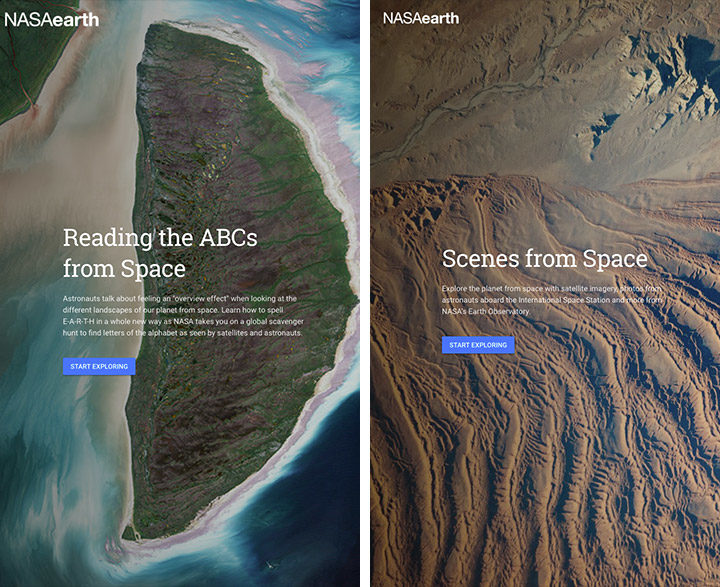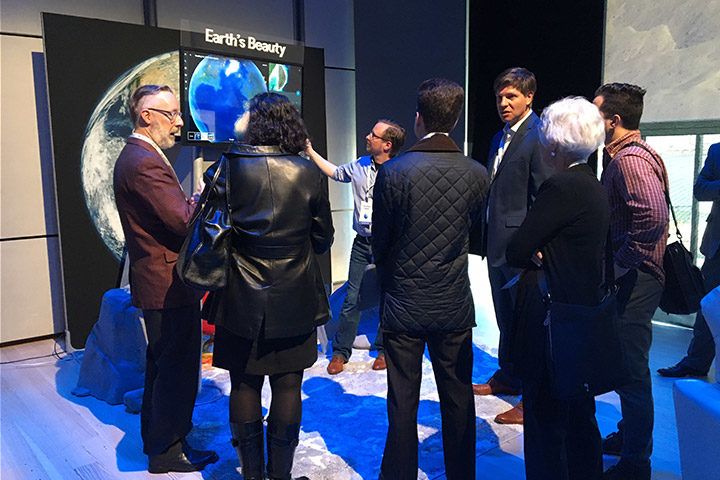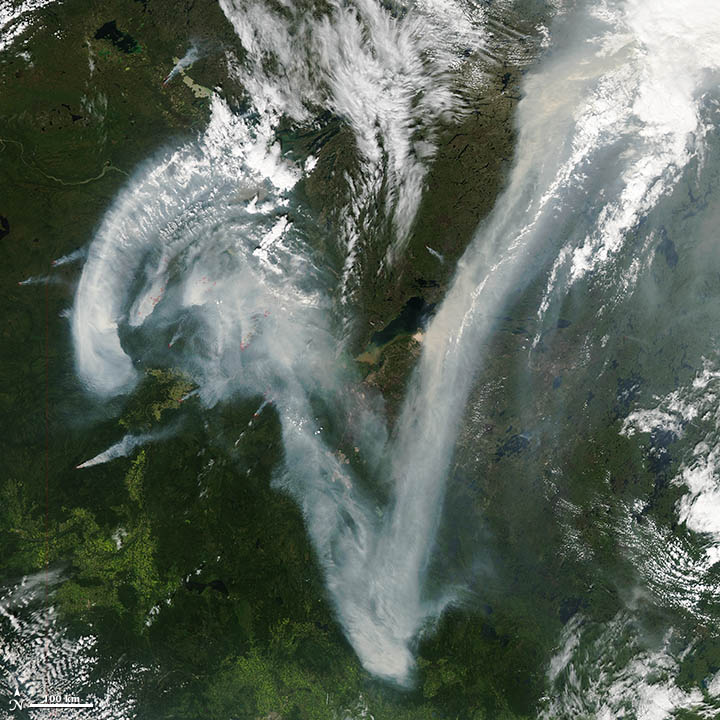

On April 18, I had the opportunity to participate in the launch of the newest version of Google Earth, which now includes some collaboration with the NASA Earth Observatory. The Google Earth team even used two image collections from EO to highlight some of the functionality of their new product.

Image Credit: Google Earth screenshot of NASA Earth Observatory imagery.
The first is Reading the ABCs from Space, which is a republishing of our planetary-scale scavenger hunt (which was partly built with assistance from our letter-hunting readers). The second collection is Scenes from Space, a curated selection of recent EO Images of the Day. The Scenes from Space collection will continue to be updated monthly by the Google Earth content team.
This launch event provided us with the opportunity to meet with media and other potential users of the 14,000 images and stories that have been produced by the Earth Observatory team since our establishment in 1999. We syndicate our content through a variety of different feed formats, and the Google Earth team will be utilizing those feeds to keep their NASA Earth content up to date.

Image Credit: NASA/Jamie Favors
We hope that other users can use these feeds for their various applications, and if you are one of those users, please let us know what we can do to help you. The vast majority of our imagery and all of our stories are freely available without any license restrictions (though we hope that you will provide proper credit). Perhaps you might even consider the Earth Observatory as a resource for the upcoming NASA Space Apps Challenge.

Image Credit: NASA Earth Observatory/Kevin Ward
As a side project, I have been filing away images to make a satellite version of the ABCs. I have most letters now, but I could still use help tracking down good examples of B, G, F, K, and Z. Since I first posted about the search, there is a new browsing tool available — called Worldview — that I highly recommend. Once you navigate to the site, just make sure you have a MODIS true color layer (either Aqua or Terra) turned on, and you can quickly start browsing for cloud formations, dust storms, smoke plumes, and much more.
When you find a letter, click the permalink button on the upper right (it looks like two links of a chain), and then post the url in the comments section below. Another great place to look is the astronaut Earth from Space gallery curated by the Johnson Space Center. The “Earth-Human Interactions” section might be especially useful for finding the straight lines needed for an upper case F, K, or Z. Though I am still missing those five letters, feel free to send any you find. Perhaps you’ll find a better example than what I already have. Good luck and happy hunting!
As a preview, here is the C and the D that I have filed away. The C is an artificial island off the southern end of Bahrain Island. The D is a rotated view of Akimiski Island in Canada’s James Bay.

NASA image courtesy Jeff Schmaltz, LANCE MODIS Rapid Response. This image was acquired on July 11, 2012, by the Aqua satellite.
One of the first things that caught my eye when I started checking for interesting satellite imagery yesterday was this: an enormous “V” of smoke draped over northern Canada, as seen by the MODIS instrument on the Aqua satellite. The plume was caused by numerous wildfires burning in the Caribou Mountains of northern Alberta.
At first glance, what looks like a decorative swash on the upper left of the V even reminded me of the look of the N we use on the Earth Observatory to indicate the orientation of an image. It made me think the two might in essence share the same typeface. In fact, the bottom point of the capital V of Adobe Jensen Pro (the typeface of our N) is much wider and curvier than the point in the smoke above. (Wired points out it also looks like the letter Z, which is true if you rotate the image clockwise a bit.)
Still, it’s a memorable image. And it made me wonder: how many other letters have satellites captured momentarily gracing Earth’s atmosphere and oceans? This is the first that I’ve noticed, but I have no doubt there are many more to find given the ceaseless mixing and swirling of clouds, smoke, dust, ice, and even phytoplankton that constantly occurs across our planet.
I think it would be fun to compile a gallery of them, so if you’ve seen a letter (or other typographical mark) in a satellite image, please let me know. Just leave a comment on the thread below. Send a link to what you’ve found, and explain what letter or other typographical mark you think you see.
If you’re feeling especially ambitious, mention what typeface it reminds you of as well. I’ll update this post as new letters come in, and perhaps we’ll eventually have the whole alphabet (plus a good collection of numbers and symbols). Sending non-English characters is ok: just note what the character is and what it’s called.
Wondering where you can look for imagery besides the EO archives? Here are a few places to try:
1) NASA Visible Earth
2) The Gateway to Astronaut Photography
3) Jet Propulsion Laboratory Photojournal
4) Scientific Visualization Studio Archives
5) MODIS Image Gallery
6) Landsat Imagery Gallery
Please note: Our gallery won’t likely include many of the high-resolution commercial satellite images that you may have seen on Google Earth because we cannot reproduce those images on our website without buying them. Besides, medium-resolution and low-resolution satellite instruments are actually better for observing large features such as clouds and smoke plumes. Here’s a list of some of the high-resolution instruments that we’ll only be using sparingly, if at all.